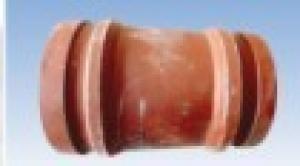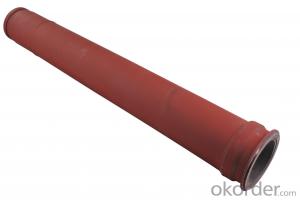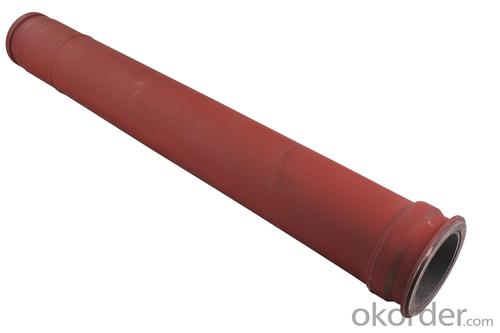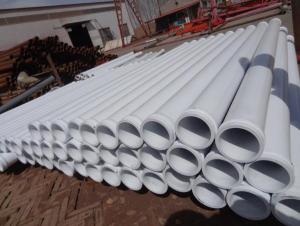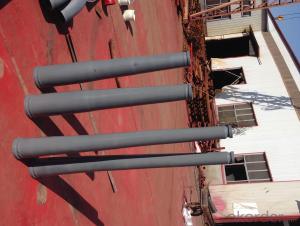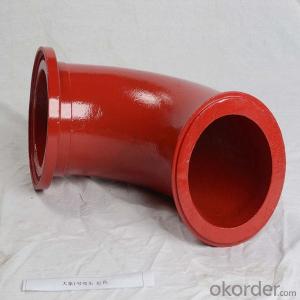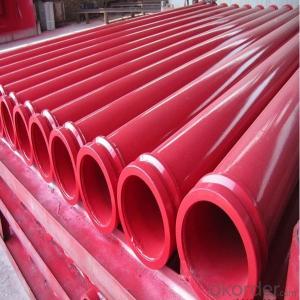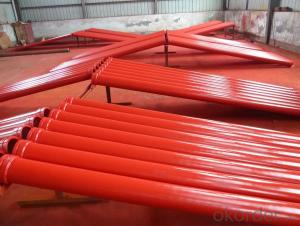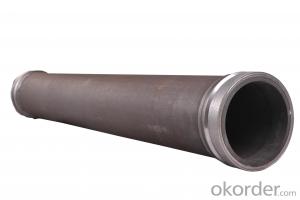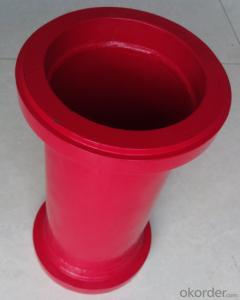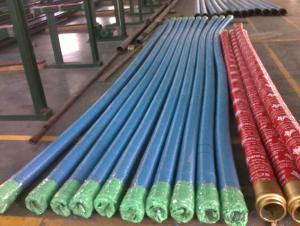Concrete Pump Parts twin wall pipe reducer pipe DN137-DN125 Length 200mm
- Loading Port:
- Tianjin
- Payment Terms:
- TT OR LC
- Min Order Qty:
- 10 pc
- Supply Capability:
- 1000 pc/month
OKorder Service Pledge
OKorder Financial Service
You Might Also Like
twin layer pump reducing pipe
1. ST52/45Mn2/20#
2. HRC: 63
3. Forged weld-on ends
4. Automatic Welding
5. Thickness: inner wall from 7mm to 10mm, inner material is high chrome alloy, outer wall is 3mm seamless steel
6.Service life: above 60,000 cubic meters
other sizes and types accofding to client's requirement
Type | DN | Thickness (mm) | Length (mm) | Weld-on Ends | Weight (kgs) | |
ST52 Steel Pipe | 125 | 4.0 | 3000/ 2000/ 1000 | 148mm | 41 | |
4.5 | 148mm | 46 | ||||
7.0 | 148mm | 72 | ||||
Hardened Pipe | 125 | 4.5 | 148mm Chrome Carbide Insert | 48 | ||
7.0 | 148mm Chrome Carbide Insert | 76 | ||||
Twin-Wall Pipe | 125 | 2+2 | 148mm Chrome Carbide Insert | 45 | ||
2.5+2 | 148mm Chrome Carbide Insert | 48 | ||||
4.5+3 | 148mm Chrome Carbide Insert | 76 | ||||
ZX-Pipe(ST52) | 125 | 7.0 | ZX-5" F/M flanges | |||
Hardened ZX-Pipe | 125 | 7.0 | ZX-5" F/M flanges | |||
Schwing F/M Pipe (ST52 ) | 125 | 4.0 | Schwing 5" F/M flanges | |||
4.5 | Schwing 5" F/M flanges | |||||
7.0 | Schwing 5" F/M flanges | |||||
8.0 | Schwing special F/M flanges | |||||
Steel Pipe | 100 | 4.5 | 3000 | 122mm/127mm/4"HD | ||
4.5 | 2000 | 122mm/127mm/4"HD | ||||
4.5 | 1000 | 122mm/127mm/4"HD | ||||
150 | 8.0 | 6000 | 6"HD/ ZX-6" F/M | |||
8.0 | 3000 | 6"HD/ ZX-6" F/M | ||||
8.0 | 1500 | 6"HD/ ZX-6" F/M | ||||
8.0 | 1000 | 6"HD/ ZX-6" F/M |

- Q: What are the signs of a malfunctioning hydraulic oil cooler?
- There are several signs that can indicate a malfunctioning hydraulic oil cooler. 1. Overheating: One of the most common signs is the engine or hydraulic system overheating. If the hydraulic oil cooler is not functioning properly, it may not be able to cool down the hydraulic fluid effectively, leading to increased temperatures in the system. This can result in reduced performance, increased wear and tear on components, and potential fluid breakdown. 2. Fluid Leaks: Another sign is the presence of hydraulic fluid leaks. A malfunctioning hydraulic oil cooler may have damaged or worn seals, gaskets, or hoses that can cause leaks. These leaks can be visible as fluid drips or puddles underneath the machinery or as oily residue on components. 3. Increased Noise: A malfunctioning hydraulic oil cooler may also cause increased noise levels in the hydraulic system. This can be due to air being introduced into the system, resulting in cavitation or aeration. These abnormal noises can indicate that the cooler is not functioning properly and may need to be inspected or replaced. 4. Elevated Temperatures: If you notice that the temperature gauge on your hydraulic system is consistently higher than normal, it could be a sign of a malfunctioning oil cooler. The cooler may not be able to effectively dissipate heat from the hydraulic fluid, causing temperatures to rise. This can lead to reduced efficiency, increased wear on components, and potential system failures. 5. Reduced Performance: A malfunctioning hydraulic oil cooler can also lead to reduced overall performance of the machinery or equipment. This can manifest as slower operation, decreased power output, or reduced hydraulic system response. If you notice a decrease in performance, it is worth checking the oil cooler for any issues. If you observe any of these signs, it is important to address the issue promptly. Continuing to operate machinery with a malfunctioning hydraulic oil cooler can lead to further damage, increased downtime, and potentially costly repairs. Consulting with a qualified technician or hydraulic specialist is recommended to diagnose and resolve any issues with the oil cooler.
- Q: What are the performance characteristics of concrete pump?
- Adopt triple pump, open system, hydraulic circuit, without interference, system operation
- Q: How to operate the concrete pump?
- The size of sand and gravel, cement mark and mixture ratio should meet the requirement of the mechanical performance of the pump according to the specifications of the factory
- Q: Are there any specific cleaning and maintenance procedures for concrete pump spare parts?
- Concrete pump spare parts require specific cleaning and maintenance procedures to ensure their proper functioning. Regular cleaning is crucial to remove any concrete buildup or residue from the parts. This can be achieved by either using a high-pressure water jet or immersing the parts in a cleaning solution specifically designed for concrete. It is vital to adhere to the manufacturer's instructions when using cleaning agents to guarantee the safety and effectiveness of the cleaning process. Furthermore, routine maintenance is necessary to extend the lifespan of the concrete pump spare parts and ensure their optimal performance. This involves inspecting the parts for any signs of wear, such as cracks or corrosion, and replacing them if needed. It is also important to lubricate the moving parts, like bearings or pistons, according to the manufacturer's recommendations. It is worth noting that different concrete pump spare parts may have unique cleaning and maintenance requirements. Therefore, it is advisable to consult the manufacturer's guidelines or seek guidance from a qualified technician to determine the appropriate procedures for each specific part.
- Q: How often should hopper pins be inspected or replaced in a concrete pump?
- Hopper pins in a concrete pump should be inspected and replaced on a regular basis to ensure the safe and efficient operation of the equipment. The frequency of inspection and replacement depends on several factors, including the usage of the concrete pump and the condition of the hopper pins. As a general guideline, hopper pins should be inspected at least once every three to six months, or after every 400 to 600 hours of operation. However, it is important to note that this timeframe can vary based on the intensity and volume of concrete pumping activities. During the inspection, the hopper pins should be carefully examined for signs of wear, damage, or deformation. Any pins that show significant signs of wear, such as cracks, elongation, or excessive corrosion, should be immediately replaced to prevent potential accidents or equipment failure. Regular inspection and replacement of hopper pins are crucial for maintaining the structural integrity of the concrete pump and ensuring the safety of both the operators and the surrounding environment. It is recommended to consult the manufacturer's guidelines or seek professional advice to determine the specific inspection and replacement schedule based on the make and model of the concrete pump.
- Q: Can I get spare parts for concrete pump wear plates and cutting rings?
- Absolutely, spare parts for concrete pump wear plates and cutting rings are readily available. These components are crucial for the flawless functioning and optimal performance of a concrete pump. Numerous manufacturers and suppliers specialize in offering spare parts exclusively for concrete pumps, encompassing wear plates and cutting rings. You have the option to directly approach these suppliers or manufacturers to inquire about the availability and pricing of these spare parts. Moreover, there are also online platforms and marketplaces where an extensive assortment of spare parts for various concrete pump models can be found. It is always advisable to ensure the purchase of genuine and top-notch spare parts to ensure the durability and effectiveness of your concrete pump.
- Q: What are the types of concrete pumps?
- According to the structure and use of divided into drag type concrete pump, car pump and pump car
- Q: How is the piping of the concrete pipe designed?
- Concrete conveying pipe is fixed, not directly supported on the reinforcing steel bar, and embedded parts, horizontal pipe should be fixed with a certain distance bracket, pad, sling etc, to facilitate the removal of plugging, dismantling and cleaning pipeline; vertical tube should be fixed on the wall or floor slab and column top hole with embedded parts
- Q: How can a faulty concrete pump control valve affect the pumping operation?
- A faulty concrete pump control valve can have several negative effects on the pumping operation. Firstly, it can cause a loss of control over the concrete flow rate. The control valve is responsible for regulating the amount of concrete being pumped, and if it is faulty, it may not be able to properly adjust the flow rate. This can lead to either too much or too little concrete being pumped, which can result in an inefficient operation. Secondly, a faulty control valve can cause inconsistent concrete flow. The valve is designed to maintain a steady and consistent flow of concrete, but if it is not functioning properly, it may result in fluctuations in the flow. This can lead to uneven distribution of the concrete, which can affect the quality and integrity of the pumped concrete. Furthermore, a faulty control valve can also contribute to increased wear and tear on the pump and other components. When the valve is not operating correctly, it can cause excessive pressure or strain on the pump, leading to increased wear on the equipment. This can result in more frequent breakdowns or the need for repairs, which can be costly and time-consuming. Overall, a faulty concrete pump control valve can significantly impact the pumping operation by causing a loss of control over the flow rate, inconsistent concrete flow, and increased wear and tear on the equipment. It is important to regularly inspect and maintain the control valve to ensure its proper functioning and avoid these negative consequences.
- Q: What are the common causes of overheating in concrete pump spare parts?
- Concrete pump spare parts can overheat due to various common causes. One primary reason is improper lubrication, which results in increased friction and overheating of the pump's moving parts like bearings and pistons. To prevent this, it is essential to regularly inspect and maintain the lubrication system to ensure smooth operation. Excessive use or continuous operation without breaks is another common cause of overheating. Concrete pumps have a designated workload, and surpassing it or neglecting proper rest periods can lead to overheating of the components. To avoid this, it is crucial to adhere to recommended operating guidelines and periodically allow the pump to cool down. Additionally, overheating can occur due to clogged or blocked cooling systems. The cooling system in a concrete pump regulates temperature by circulating coolant around vital parts. If the system gets clogged or the coolant level is insufficient, overheating may occur. Regular inspection, cleaning, and maintaining appropriate coolant levels can prevent this issue. Inadequate ventilation is also a common cause of overheating. Concrete pumps generate substantial heat during operation, and if the surrounding environment lacks proper airflow, the heat cannot dissipate effectively. This can lead to overheating of spare parts. To avoid this, it is important to operate the pump in well-ventilated areas or utilize additional cooling measures like fans or air conditioning. Lastly, a malfunctioning or damaged pump component can cause overheating. When a part such as the motor or hydraulic system does not function correctly, it places additional strain on other components, resulting in overheating. Regular maintenance and inspection of the pump's components can help identify and address any potential issues before they lead to overheating. In conclusion, preventing overheating in concrete pump spare parts requires proper lubrication, adherence to operating guidelines, maintenance of cooling systems, ensuring adequate ventilation, and regular component inspection.
Send your message to us
Concrete Pump Parts twin wall pipe reducer pipe DN137-DN125 Length 200mm
- Loading Port:
- Tianjin
- Payment Terms:
- TT OR LC
- Min Order Qty:
- 10 pc
- Supply Capability:
- 1000 pc/month
OKorder Service Pledge
OKorder Financial Service
Similar products
Hot products
Hot Searches
Related keywords
